© 2023 - All Rights Reserved

The Woodpeckers of Utopia.
Here we will give an illustrated overview of the woodpeckers of the Utopia area. We compile all the various woodpecker pix scattered about the site, and add a few new ones, as well as give some info on the ID and status of each type here.
We are not exactly covered in woodpeckers here, only two species are breeding permanent (year-round) residents locally. We do real well with oriole or vireo diversity here, woodpeckers not so much. Besides our two residents, two more species show up in winter in low numbers annually. Then two more species are semi-regular (LTA - less than annual) visitors here, one of which bred once. Very rarely a few vagrant species have occurred (three in last 20 years).
Woodpeckers mostly eat insect larvae that are pests to trees, such as beetle larvae in particular, that nothing else can get to. They help keep trees healthy despite the odd hole they may drill for a nest. If they seem to be attacking a tree it is because it is full of beetle larvae. They are a sign of a problem, not the problem. I fear Woody the Woodpecker has misled people.
Their skulls have a special shock absorbing material in them allowing them to hammer on oak without doing damage to themselves. Their tongues are coiled up in head and unbelieveably long, to get the deepest beetle larvae out. If you get some at a hummingbird feeder you might see this. Be careful what you wish for. They drum instead of sing, to announce territory, and likely otherwise communicate. They use their tails as a prop when hanging on tree trunks.
Most of the nest holes used by all the various cavity nesters are made by woodpeckers. Over the years they provide more nest holes for other species than they use themselves. Big users of old woodpecker holes for nesting here are Eastern Bluebird, Carolina Chickadee, Black-crested Titmouse, and Ash-throated Flycatcher to name a few. In winter they often eat nuts and besides Pecans, various oaks and live-oaks with their acorns are favored.
Woodpeckers can be easily seen as they are often out in the open on tree trunks and usually somewhat tame. Sexes differ, usually regarding the presence or amount of red on the head. We have two permanent resident species here, that is, found year-round and non-migratory. Ladder-backed, and Golden-fronted, woodpeckers. They both sometimes will use nest boxes to roost in, in winter, though I have yet to ever see them nest in one.
Woodpeckers are fairly easy to ID, save perhaps two pairs here in winter only, the Sapsuckers and Flickers. The Sapsuckers one needs a good look at to sort which it is. Then there are many (10% or more) intergrade or hybrid Northern Flicker here, so getting good enough looks to claim a pure Yellow-SHAFTED vs. Red-SHAFTED can be hard some times. Just call them Northern Flicker and leave it at that, done. Flight views are not enough, those are only Red-WINGED or Yellow-WINGED flickers. Often whisker, nape crescent, face or crown color does not match wing color and they are hybrids, intergrades, back-crosses, etcetera.
Below the photo section we cut in a modified version of the woodpecker section from the bird list page, showing status of all nine species known here. Here we only show the six regular species so far. Will find my pic of that imm. Red-headed that wintered at Roy's to add. Also have another Red-nape, a Red-shafted Flicker, a female Ladder-backed, not to mention the tongue of one at a hummer feeder, etc., to add. Will add more pics in time.
~ ~ ~ ~ ~ ~
First we will start with our two resident species, which are present year round and breed here, the Ladder-backed and Golden-fronted woodpeckers. Most of the woodpeckers you see here are one of these two. Both are 'zebra striped' above with narrow black and white bars. They are quite fond of Pecans when available. The larger Golden-fronted is often on power poles along roads, or high up in bigger trees. Ladder-backed are usually lower down in shorter denser trees. I have seen as many Ladder-backs sitting crosswise on power LINES as on the poles themselves.
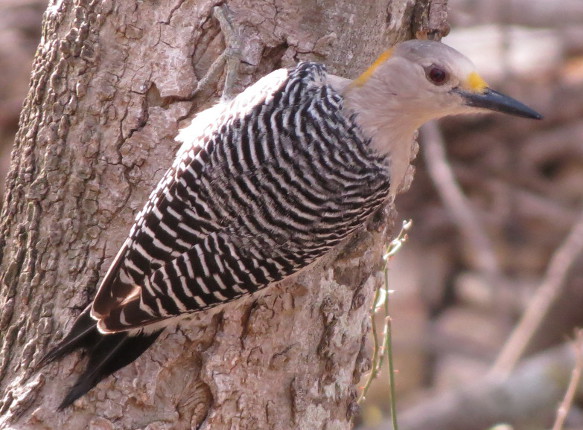
This is a female Golden-fronted Woodpecker. Named for the golden nasal tuft at front of head and base of bill. Note also the golden nape patch at rear of head. Probably 99.99% of their U.S. range is within Texas, a few are in Oklahoma along the panhandle. It is essentially a Texas endemic species in the U.S., though widespread in Mexico. Every birder on their first visit to Texas has it on their want list.

Male Golden-fronted Woodpecker has red patch on crown, and more extensive brighter nape patch, often infused with orange or red feathers. The eye gets brighter red during breeding season, as here.

It is not unusual for a male to have some red feathers in the orange-gold nape patch. Note eye is darker in winter.


Male Golden-fronted Woodpecker eating sunflower seeds off patio. When poor pecan crops, they will take to sunflower seeds at a feeder. Be careful what you wish for. They are unmarked tan on face and anterior (forward) underparts.
The Ladder-backed Woodpecker is smaller than Golden-fronted, and more widespread and common. Ladder-backed are on a mission to enlarge the entrance hole of every nest box they find. Which then later makes predation easier, and allows more rain in. So make nestbox roofs with a 3-4" overhang on front but better if also on both sides. Keeps predators and rain out, and shades box in sun.
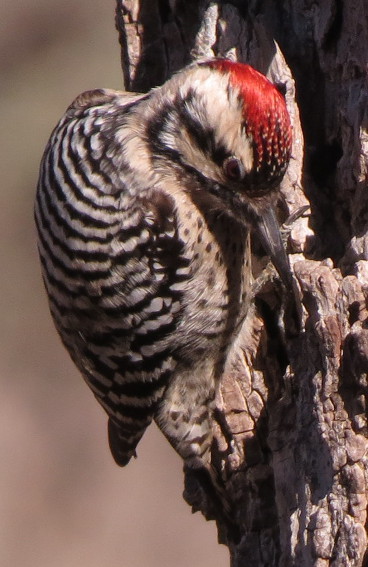
Ladder-backed Woodpecker, male. Note back is evenly zebra- barred throughought upperparts and wings. The female crown is black without the red. These are the most common woodpecker here and are widespread residents. Note the black facial stripe makes a horseshoe or U on its side, looping back from eye, and returning to bill without connecting to the black nape stripe, and is completely encircled with white.
Twice I have seen Ladder-backed Woodpecker fly a 360 degree full circle loop! They are incredibly deft in the air. I presume zinging about the short dense woodlands here would do that to you.

Another male Ladder-backed, female crown all black without red.
The Downy Woodpecker, our smallest Woodpecker, is somewhat of an enigma here. It might be seen any month, but you can easily go a year or two without seeing one. Just in 2020 our first ever breeding was discovered. It is found east of us along the Guadalupe and scarcely the Medina River drainages (on Edwards Plateau), but historically is not known along Sabinal, Frio, or Nueces Rivers up on the Edwards Plateau. We get semi-regular strays, some of which hang around a month or two, and once we know of, nested. They are almost always along water, as river or creek, in leafy deciduous riparian habitat.
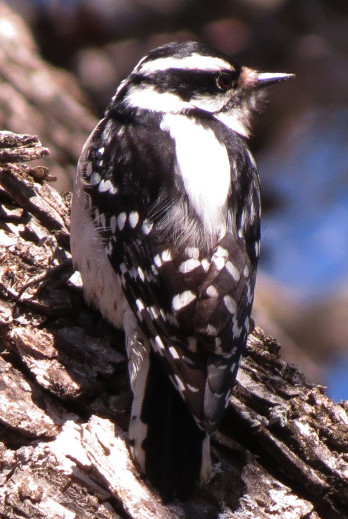
Downy Woodpecker, female. Note big white stripe up back that otherwise appears mostly black. The spots are on the wings. Males have a small red patch at top rear of crown. Note black facial (eye) stripe a thick line narrowing rearward, but straight, connecting to black nape stripe, breaking the white stripes on head.

Poor pic of male Downy showing little red square at back top corner of head. Note big white stripe up back. Also note the pointed tips of tail feathers, typical of woodpeckers.

This is the female Downy Woodpecker that was attending begging young just south of town May 11, 2020. This is the first Sabinal River drainage nesting record. I could not see the nest on private property, but was listening to at least two begging young while I took this photo. The staining on the face which normally just pure black and white is the result of digging the nest hole in the tree.
The Flicker and Sapsuckers are winter woodpeckers here.
Northern Flicker is the biggest woodpecker here, present from October to March, sometimes April. Northern Flicker come in two flavors (subspecies) here, formerly two species, the Yellow-shafted and Red-shafted. There are a large number of impure birds. Hybrids, back-crosses, intergrades, etc., are numerous enough that you cannot call them -SHAFTED without verifying crown vs. face, and whisker vs. nape crescent colors against underwing color. The intermediate tweener orange-winged ones are the easy ones to tell as hybrids.

The underwing and undertail are red, or yellow, and there are hybrids that are orange. Also hybrids can have the yellow or red underwing and tail, and have just the wrong whisker or nape crescent color be the only external clue. This pic is the Yellow-shafted type. Note yellow undertail on next pic below. Flicker eat ants, often feeding on ground. Tan brown above with black barring, and boldly spotted below.

Big black chest crescent (smaller sapsucker has one too). Check face and crown color, and whisker and nape crescent color, to verify a pure Red-shafted or Yellow-shafted type. They can also be sexed by whisker and nape crescent details.
Sapsuckers are here late fall to spring. They drill holes in neat horizontal rows in trees creating sap wells to drink from, as well as eat trapped insects. They have a big white patch along the edge of wing when perched on tree trunk. We have 2.5 types here and they require a good close look to sort. Yellow-bellied is the most common and our default sapsucker, all are Yellow-bellied, until proven otherwise. Red-naped are almost annual but do not show up every year. The .5 is a hybrid (photo below ) in which one parent was a Red-breasted Sapsucker, noteworthy since that is a very rare accidental vagrant in Texas.

This is a female Yellow-bellied Sapsucker, note all white throat. Note big black crescent on breast not present on intergrade or hybrid sapsucker below.

This is a male Yellow-bellied Sapsucker. Note thick complete black frame to red throat. On Red-naped the black malar line from bill is broken, not solid, and so in some places red touches the white.

The adult male Yellow-bellied throat is stunning in the sun.

This is a late first winter Yellow-bellied just getting head stripes in, quite muddy brown and messy all over, with no chest crescent yet.

This is a first fall Red-naped Sapsucker. Of the Yellow-bellied and Red-naped, adults have a big black chest crescent only half present here, and clean unmuddied underparts. So this is a young bird of the year (photo is mid-Nov.). Young Yellow-bellied do not get this adult type black and white head or chest crescent until the first spring, staying muddy brown washed of head and breast through the first fall into winter until spring. Some start showing head stripes coming in mid-winter or so, but no chest crescent in fall or early winter.
A hybrid sapsucker
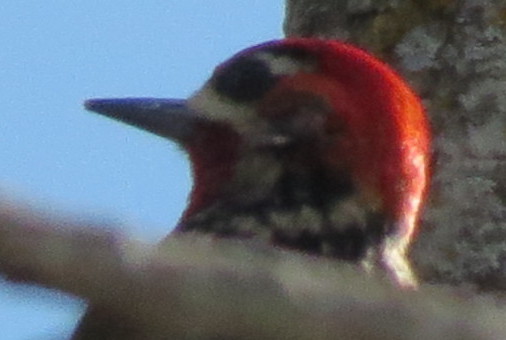
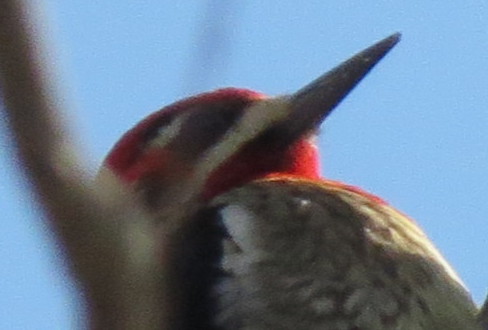
This hybrid or intergrade sapsucker was seen Feb. 21, 2020. Note on the top pic the amount of red on head is out of limits for normal Red-naped or Yellow-bellied Sapsucker. One or the other is likely one parent. However this requires Red-breasted Sapsucker genes. On the second pic note red on breast below throat, again, requiring Red-breasted genes. Note also there is no black crescent on the breast. Note the solid red forehead to nape over crown. It could be some sort of backcross or who knows what kind of combo. It is of interest in Texas since it is partly Red-breasted Sapsucker for which there are only a few accepted records in the state.
Here is a slightly modified Woodpecker list from the Bird List page.
Woodpeckers - 9 species recorded, 2 nest regularly
RESIDENTS
Golden-fronted Woodpecker - Nests, uncommon breeding resident.
Ladder-backed Woodpecker - Nests, common breeding resident.
Downy Woodpecker - itinerant resident, not annual, any season, nested in 2020.
WINTER VISITORS (late fall to mid-spring)
Yellow-bellied Sapsucker - uncommon fall to spring, can be scarce.
Red-naped Sapsucker - scarce, irregular, not annual, fall to early spring.
Northern Flicker - uncommon fall to spring.
a) "Yellow-shafted" uncommon, around 60-70% here.
b) "Red-shafted" occasional, varies 10-20% here.
c) "Orange-winged Flicker" about 5-10% here.
d) hybrids-intergrades only detectable on head: 5-10% here.
VAGRANT RARITIES (take photos!)
Lewis's Woodpecker - accidental Jan. 04, 2004 and after, 3 mi. N. of Utopia in pecan bottom.
Red-headed Woodpecker - accidental, imm. winter 2005-06 at Roy Heideman's (BanderaCo.).
Acorn Woodpecker - accidental, Feb 2010 at R. Heideman's (BanderaCo.); April 2014 at LM.
*Note there is a historical Williamson's Sapsucker record from northern Uvalde Co. on the Nueces River, another at Kerrville, and three (!) in Travis Co., so a possible but incredibly unlikely vagrant.
~ ~ ~ ~ ~ ~
These last two are not woodpeckers, but are usually seen on tree trunks.
The little (5") Brown Creeper is not a woodpecker.

Brown Creeper moves from trunk to trunk working them from the ground up.
The also small (4.5") Red-breasted Nuthatch is also not a woodpecker.

Nutchatches work tree trunks downward, in a head-down position.
We hope you enjoyed this look into the woodpeckers of Utopia.
~ ~ ~ ~ ~
THE END

If you have arrived here from our Bird Photos page, you may close your browser to return to the Bird Photos index.
Other visitors may click your "Back" button on your browser or select a link to keep visiting!

To Bird Photo Main Menu

To Butterfly Pics

To Dragonfly & Damselfly Pics

To Current Bird News
Birds
Utopia Birds
Birding Sites
Bird List
Bird Guide
Reports from Lost Maples
Winter Bird Count
Butterflies
Butterfly News
Butterfly List
Butterfly Photos
Rare Butterflies
Dragonflies
Critters, Bugs, & Stuff
Lost Maples
Garner State Park
Local Site Guide
Home

Our E-mail
mitch @ utopianature.com
 All photographs within this site are copyrighted
All photographs within this site are copyrighted